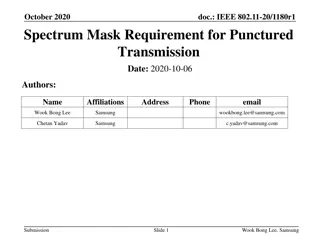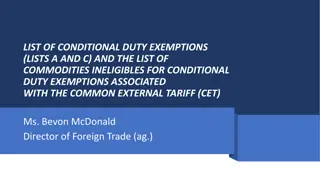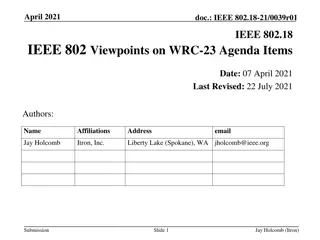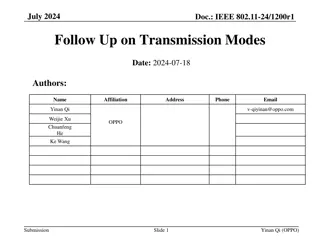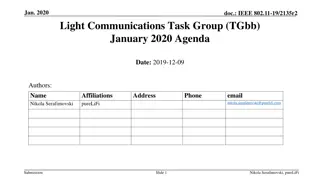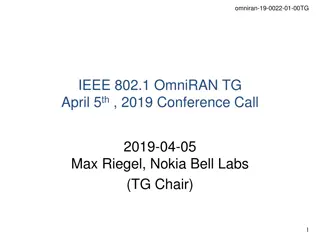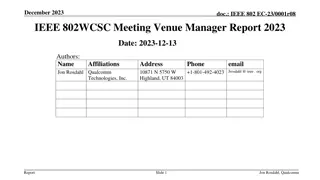IEEE 802.11-24/1305r0: High Duty Cycle NB Transmission vs. Wi-Fi
Discusses the impact of multiple high duty cycle NB connections on Wi-Fi channel access latency, proposing solutions such as prioritizing specific unused channels and enforcing stricter channel access requirements. The presentation highlights the challenges faced and potential remedies to improve channel access delay in high-density wireless environments.
Download Presentation

Please find below an Image/Link to download the presentation.
The content on the website is provided AS IS for your information and personal use only. It may not be sold, licensed, or shared on other websites without obtaining consent from the author. Download presentation by click this link. If you encounter any issues during the download, it is possible that the publisher has removed the file from their server.
E N D
Presentation Transcript
July 2024 doc.: IEEE 802.11-24/1305r0 High Duty Cycle NB Transmission vs Wi-Fi Date: 2024-07-17 Authors: Name Ratnesh Kumbhkar Affiliations Intel Corporation Address Phone email ratnesh.kumbhkar@intel.com Submission Slide 1 Ratnesh Kumbhkar, Intel
July 2024 doc.: IEEE 802.11-24/1305r0 Problem Description Multiple high duty cycle NB connection can result in very high channel access latency for Wi-Fi The topic has been discussed in the IEEE Coex SC [1][2] Submission Slide 2 Ratnesh Kumbhkar, Intel
July 2024 doc.: IEEE 802.11-24/1305r0 Channel Access Delay for Wi-Fi 240 channels All links located in 20m 20m area Bluetooth is the NB transmitter Uses secondary channel deferral Each link has a central & peripheral device Connection interval = 7.5ms Packet size = variable Wi-Fi AP of different bandwidth tries to access the channel Channel access delay: time from packet arrival to start of transmission 99%ile shown in the plots 100ms 50ms 20ms Submission Slide 3 Ratnesh Kumbhkar, Intel
July 2024 doc.: IEEE 802.11-24/1305r0 Potential Solutions Prioritize certain part of the band that is not used by Wi-Fi for high duty cycle transmission Stricter requirements for channel access for high duty cycle transmission Efforts by NB Efforts by Wi-Fi Submission Slide 4 Ratnesh Kumbhkar, Intel
July 2024 doc.: IEEE 802.11-24/1305r0 Prioritized Channels Certain portions of 5 and 6 GHz are either lightly used or not used by Wi-Fi Ch144, 5710-5730 MHz (UNII-2C/UNII-3) Ch169, 5835-5855 MHz (UNII-3/UNII-4) 5925-5945 MHz (UNII-5) Prioritize these channels when NB wants to use high duty cycle NB transmission Submission Slide 5 Ratnesh Kumbhkar, Intel
July 2024 doc.: IEEE 802.11-24/1305r0 Example: 10 Prioritized channels Uniform probability of all channels Probability of selecting prioritized channels = 10% Probability of selecting prioritized channels = 25% Wi-Fi channel access latency improves Higher failure rate of NB channel access Submission Slide 6 Ratnesh Kumbhkar, Intel
July 2024 doc.: IEEE 802.11-24/1305r0 Stringent Requirements For Channel Access The fundamental issue arises when a NB begins transmitting on a Wi-Fi channel that is already occupied by an ongoing NB transmission. A potential solution could involve setting a higher threshold for channel access when NB wants to use high duty cycle NB transmission, thereby reducing the likelihood of concurrent transmissions within a single band. CCA deferral cca-2 20MHz cca-k NB TX cca-1 Submission Slide 7 Ratnesh Kumbhkar, Intel
July 2024 doc.: IEEE 802.11-24/1305r0 Example Number of CCAs = 2 Number of CCAs = 3 Number of CCAs = 5 For a similar degradation in NB performance, the improvement in Wi-Fi latency is not as good as using prioritized channels Submission Slide 8 Ratnesh Kumbhkar, Intel
July 2024 doc.: IEEE 802.11-24/1305r0 Summary Giving preference to channels with lower Wi-Fi usage for high duty cycle NB transmissions might be advantageous A simpler solution that might be easier to implement Setting a stringent channel access requirement is not as useful as using a set of prioritized channels Submission Slide 9 Ratnesh Kumbhkar, Intel
July 2024 doc.: IEEE 802.11-24/1305r0 Reference [1] IEEE 802.11-24/1138r0: Narrowband Frequency-Hopping blocking Wideband, Sebastian Max (Ericsson) [2] IEEE 802.11-24/1150r1: NB hop density, Menzo Wentink (Qualcomm) Submission Slide 10 Ratnesh Kumbhkar, Intel







